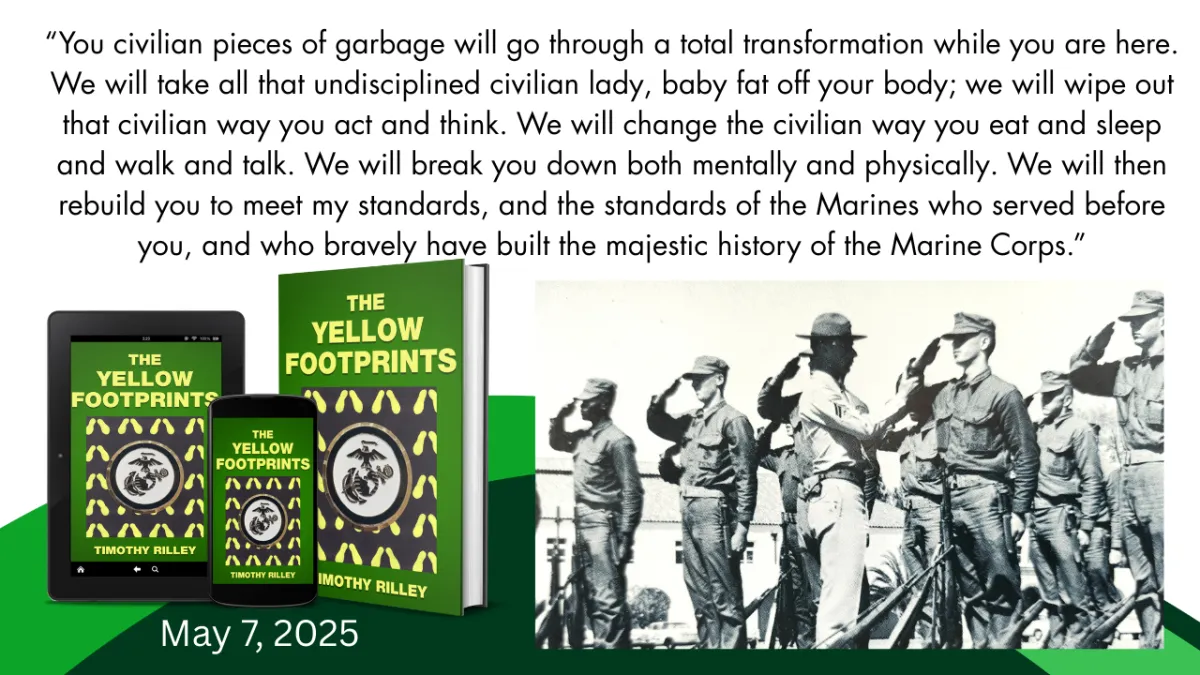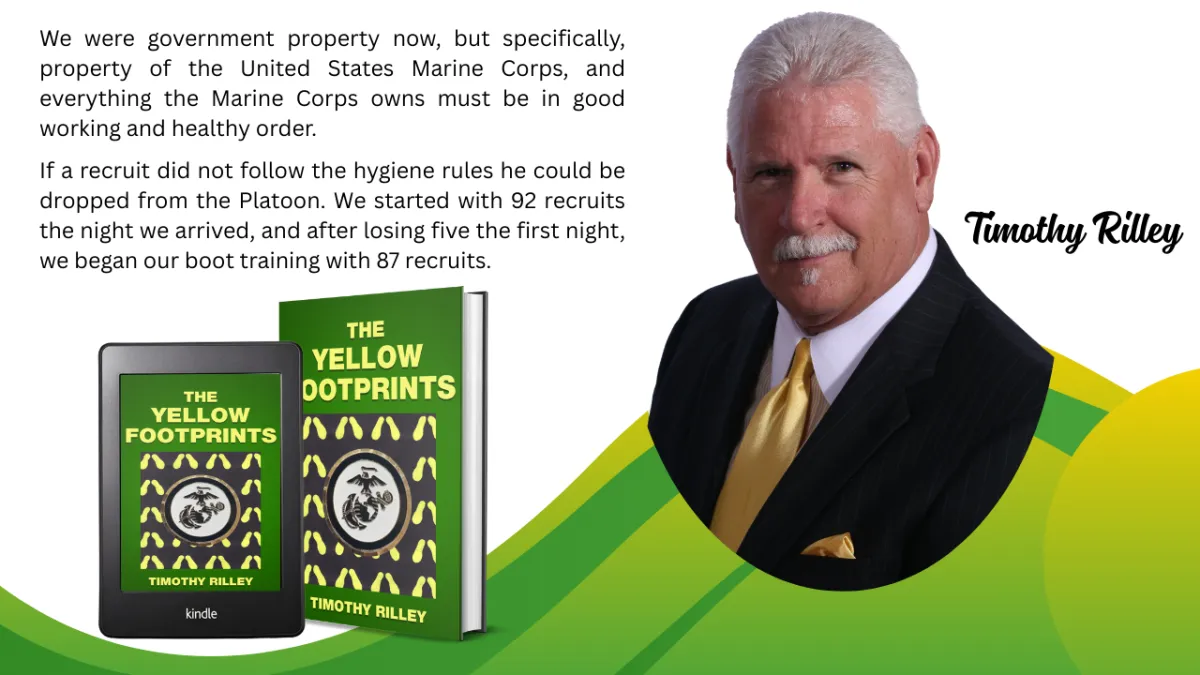The Yellow Footprints
Timothy Rilley
Standing on the Yellow Footprints: The Crucible That Forges a Marine
You exit the bus into the wet California evening. The air is heavy with fear and the acrid, unmistakable ring of screaming. Your own eyes, still wide with civilian incredulity, are drawn to the lines of colored yellow footprints on the ground. You're told to stand on them, heels together, feet at 45 degrees. In this instant, your former life ceases. You are no longer a college dropout, a boy, a boyfriend. You are a lowlife recruit.
This is the unedited, opening page of Timothy Rilley's memoir, The Yellow Footprints, a riveting, blow-by-blow account of his experience at Marine Corps boot camp in 1966. It is no war story, though, but an account for all time of transformation-an exact blueprint of the tough path from self to brother, from sloth to discipline, and from boy to man.
The Breaking Point
Rilley's story begins with a familiar dilemma for the era: a draft notice. Kicked out of college and with summer plans looming, the "Greetings" from the President of the United States was an unwelcome interruption. In a moment of panic-fueled ingenuity, he found a Marine Corps recruiter who offered a deal: enlist, and you can delay your report date long enough to enjoy your summer and attend your family weddings. It was a decision that would trade a few months of freedom for a lifetime of identity.
The book masterfully chronicles the deliberate and brutal process of deconstruction that begins the moment recruits land in San Diego. The chaos is not accidental; it is by design. Drill Instructors (Dis) swarm the new arrivals, herding them like cattle, their voices instruments of psychological warfare. The first night is a blur of forced haircuts (bald in under a minute), stripping off civilian clothes that are boxed and mailed home, and standing naked for inspections that leave no shred of dignity intact.
"The Di's use what is known as the 'mass punishment' process," Rilley writes. "One person screws up and the entire platoon pays for it." This lesson is learned through endless, agonizing push-ups-a unifying language of pain that teaches the first core tenet of the Marines: the group is everything, the individual is nothing.

The Building Back
But boot camp is not merely about breaking you down. The second, more profound phase is about you back up in the vacant space. Rilley's narrative shifts from chaos to meticulous order, mirroring the recruits' own transformation. He details the almost spiritual process of learning to make a "rack" (a bed) with perfect, quarter-bouncing hospital corners. He describes the precise placement of every item in a footlocker, the specific way to stamp a name on every piece of clothing and gear, and the sacred ritual of spit-shining boots.
This attention to detail is not trivial. It is the foundation of the Marine Corps ethos. If you can be trusted to care for the smallest, most mundane task with perfection, you can be trusted with a rifle, with a mission, and with the life of the Marine beside you.
A key turning point in the book, and in Rilley's journey, is when he is unexpectedly chosen to be the Platoon's "Right Guide"-the recruit who carries the platoon's guidon (flag). This honor, bestowed by the terrifying Platoon Commander, GySgt Wolfmule, is a recognition of emerging leadership and discipline. It is a moment where the constant criticism is punctuated by a flicker of validation, fueling a new sense of purpose not just in Rilley, but in the entire platoon as they begin to cohere into a single unit.
The Tools and the Tests
The narrative is rich with the specifics of training that will be nostalgic for veterans and fascinating for civilians. Rilley vividly describes the weight and smell of his newly issued M-14 rifle, a weapon he would learn to disassemble, clean, and march with until it felt like an extension of his own body. He walks the reader through the terrifying "Confidence Course," with its towering ropes and log obstacles designed to conquer fear, and the grueling bayonet training that awakened a primal aggression.
Throughout this physical ordeal, the mental training is relentless. The "Little Red Notebook" containing the 11 General Orders becomes a constant companion. Recruits are expected to memorize them verbatim, learning the sacred responsibilities of a sentry. Every meal begins with a sharp salute to one's own reflection in a mirror outside the mess hall; a daily reinforcement of the new identity being forged.
A Brotherhood Forged in Memory
Looming over the entire narrative is the poignant, real-life story of LCPL Michael W. Havranek, to whom the book is dedicated. Havranek was Rilley's squad leader, a natural leader who graduated with him and achieved the highest rifle score in their platoon. His dream was to be a Recon Marine. In the book's dedication and random introspections, the sorrowful end to this dream is revealed: Havranek died in Vietnam on June 11, 1967, when his helicopter was hit by rocketfire and went down. His body was never recovered.
This information adds a depth of seriousness to the boot camp story. The intense exercises, the tough-attitude of the Dis, the endless push-ups-it was all leading up to a brutal reality. The bonds formed on the yellow footprints and the grinder would be tested on distant battlefields, and not everyone would be returning home.
The Yellow Footprints is more than a military memoir; it is a masterclass in transformation. It answers the question civilians have always asked: "What does it really take?" Timothy Rilley doesn't just tell you. With unflinching honesty and meticulous detail, he makes you stand on those yellow footprints, feel the fear, endure the pain, and ultimately, understand the pride of earning the title so few can claim: United States Marine.


Facebook
Instagram
LinkedIn